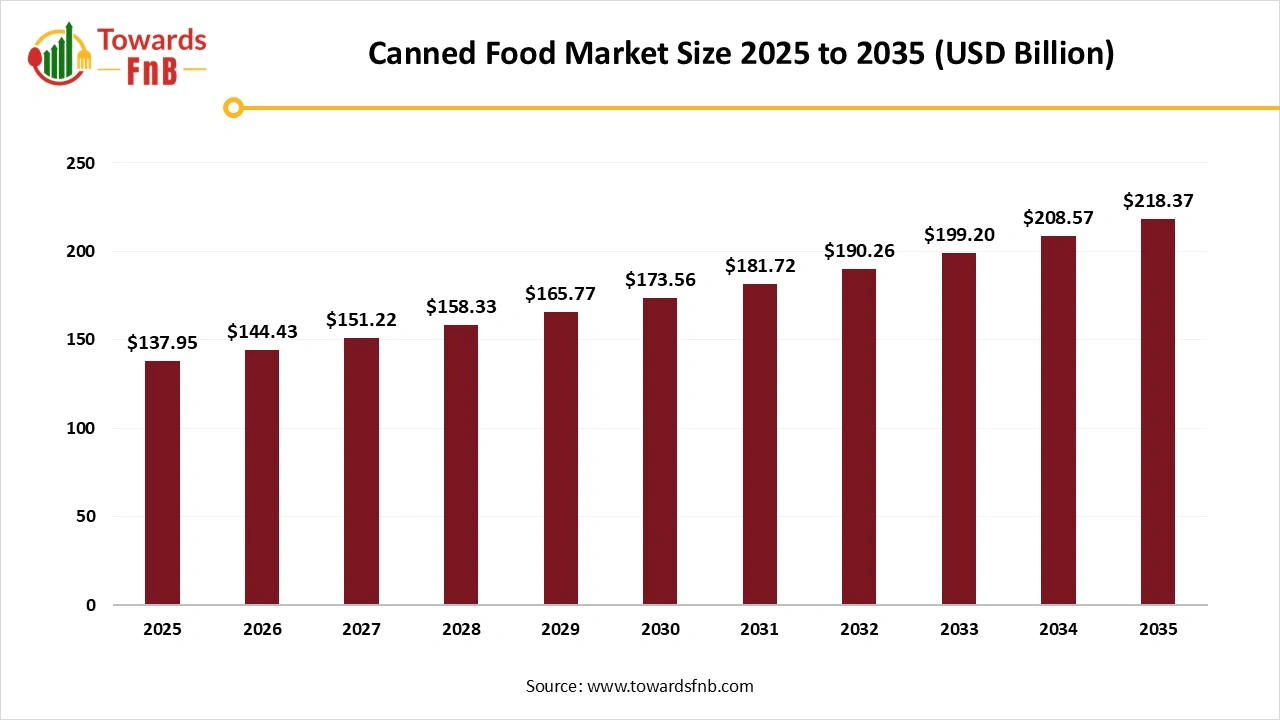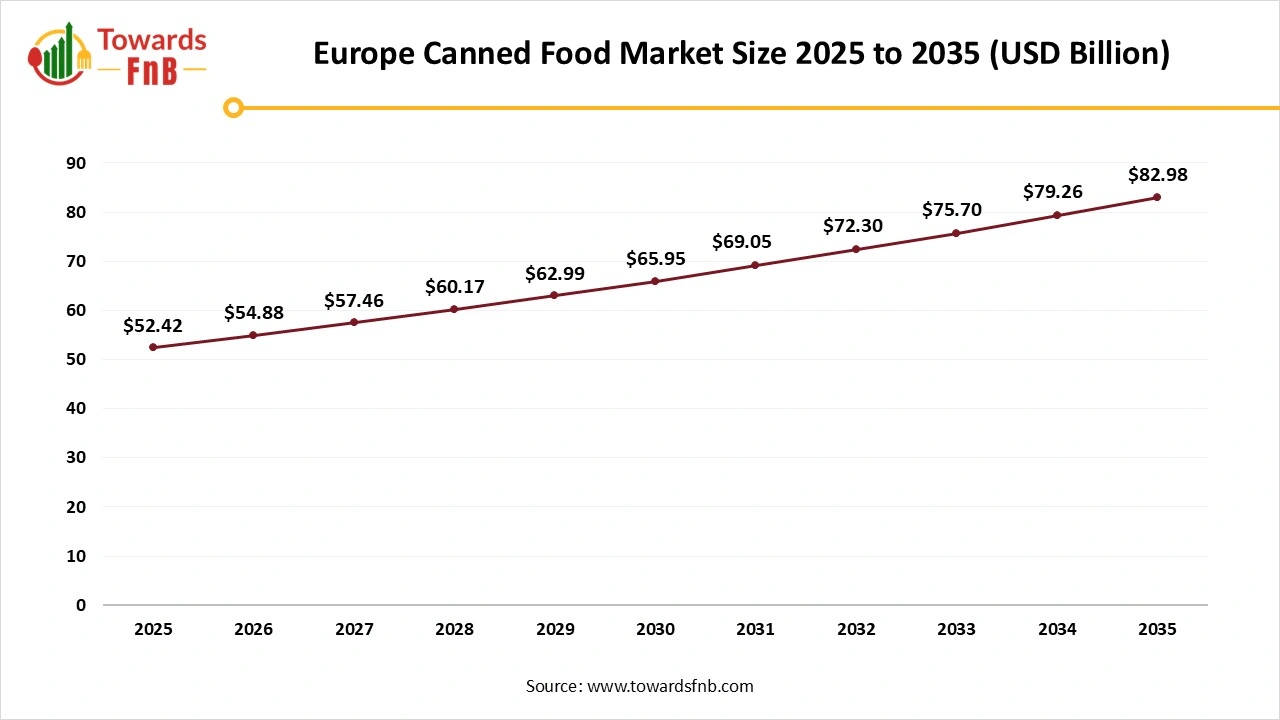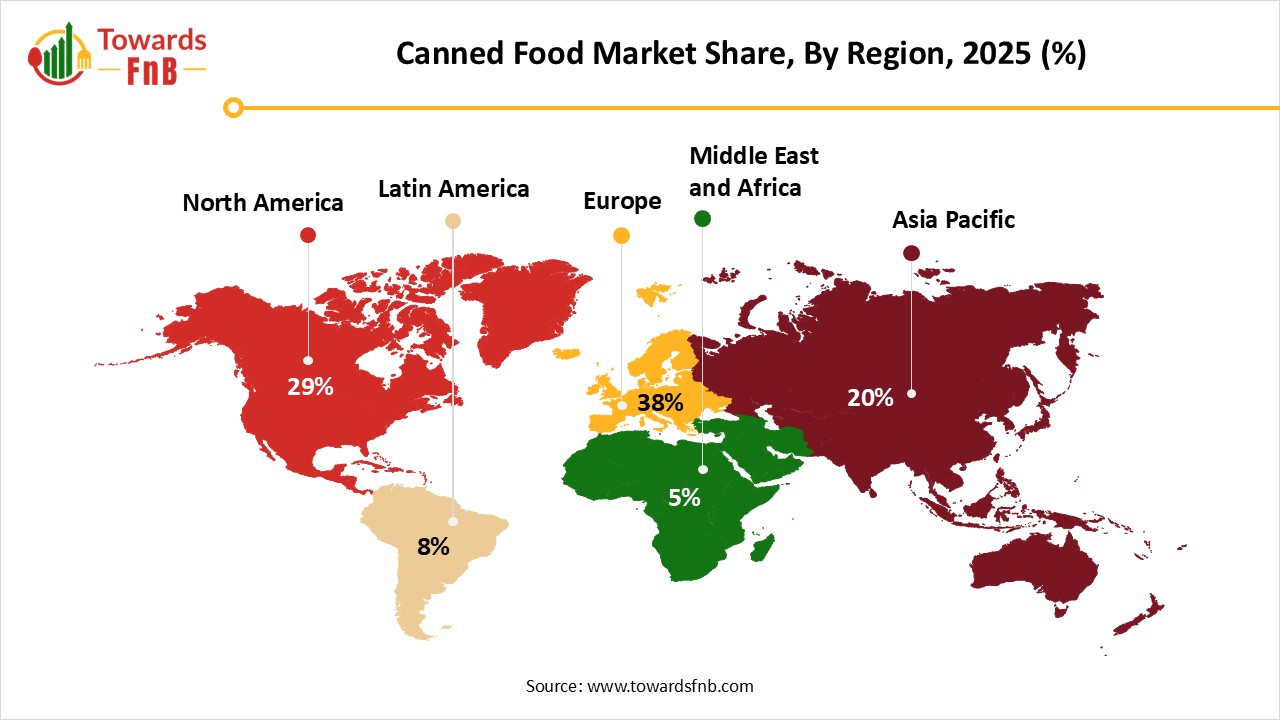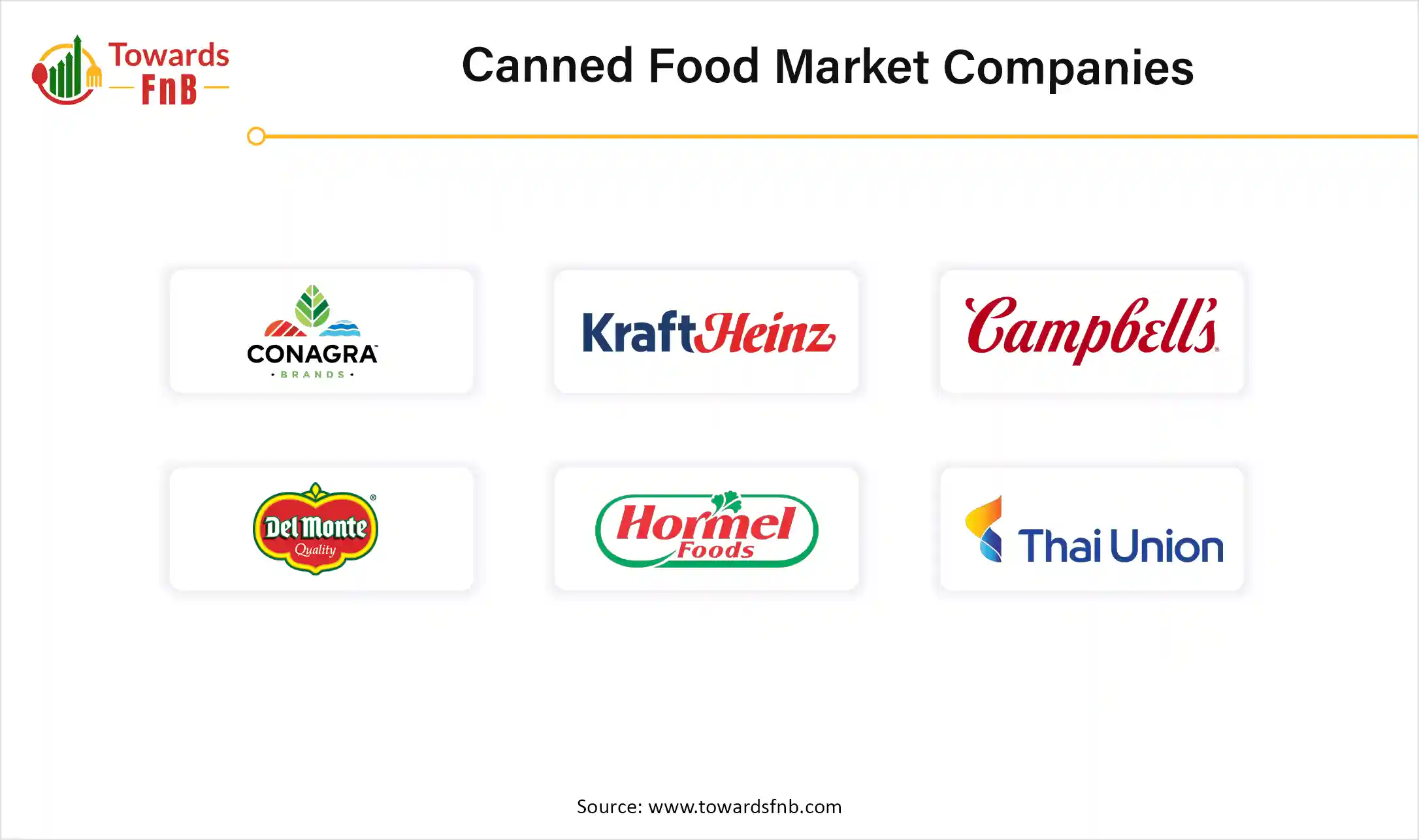December 2025
The global canned food market size stood at USD 137.95 billion in 2025 and is forecasted to expand from USD 144.43 billion in 2026 to approximately USD 218.37 billion by 2035, at a compound annual growth rate (CAGR) of 4.7% during the forecast period from 2026 to 2035. The growing demand for clean label products with fewer artificial preservatives, which have fuelled the expansion of global canned products.

| Study Coverage | Details |
| Growth Rate from 2026 to 2035 | CAGR of 4.7% |
| Market Size in 2026 | USD 144.43 Billion |
| Market Size in 2027 | USD 151.22 Billion |
| Market Size by 2035 | USD 218.37 Billion |
| Largest Market | Europe |
| Base Year | 2025 |
| Forecast Period | 2026 to 2035 |
| Regions Covered | North America, Europe, Asia-Pacific, Latin America, and Middle East & Africa |
Canned food is a process in which food is preserved through a procedure called “canning,” which involves food heating in hermetically sealed containers in order to destroy microorganisms and enzymes in order to extend its shelf life. In the canning process, food is first placed in a jar, then the jars are sealed tightly to prevent air and microorganisms from entering them, and lastly, these sealed containers are heated at a specific temperature to destroy bacteria and enzymes, which can lead to spoilage because this procedure ensures that food remains fresh, safe, and edible for a longer period.
| Company | Innovations |
| Beyond Meat | Plant-based meat alternatives |
| Wild Planet Foods W | High-protein canned seafood |
| D'Artagnan | Gourmet canned meat |
| Applegate Farms | Clean-label canned meats |
| Asia Fusion Foods | Ethnic-inspired canned meats |
| Primal Kitchen | Keto-friendly canned meats |
| Organic Valley | Organic canned meats |
| Hormel Foods | Ready-to-eat canned meats |
| Carnivore Club | Limited edition canned meats |
| ButcherBox | Customizable canned meat kits |
The major market driver for canned food is increased demand for long-shelf-life and eco-friendly food options due to technological advancements, sustainability initiatives, and changing consumer preferences, which are contributing factors. Apart from this, there is the movement of shift towards clean labels, which is driving consumers towards clean labels and wholesome products too, as they want to be aware of where they are consuming food.
The growing health consciousness among consumers, which is raising interest in canned food that is rich in nutrients, and several manufacturers are focusing on canned food without adding preservatives, sugars, and sodium too. Also, there are diverse food ranges available in canned food, such as canned food, soups, fruits, and seafood is driving the growth of the market.
The rising adoption of the recyclable and sustainable packaging solution and the food processing industry has significant opportunities for the food can market. The growing demand for packaged and ready-to-eat food increases the need for food cans. Consumers are preferring food products that have a longer shelf life while at the same time maintaining their nutritional value.
Edible and biodegradable packaging, which is made from plant-based fibers, seaweed, or food starch, has emerged as a trend, and eco-friendly packaging like reusable packaging is driving the trend. There are also some industry and sector opportunities for canned food, such as Advanced sealing techniques should be utilized in airtight cans, as sealing plays an important role in the growth of the market.
The excessive use of canned food hampers the health of the consumer due to its preservative content and other additional chemical that used for preserving and extending the lifecycle of the product. It may severally affect the digestion and immune system of the consumer, the regular consumption of canned food can have a high amount of sugar and trans-fat, which may cause obesity, high cholesterol level increase, and even diabetes. Thus, the growing awareness about health in the people limits the growth of the market.
In the canned food industry, the raw material procurement deals with strategic procedure of purchasing, evaluating, processing, sourcing and packaging of clean-label and gluten free food products from the various natural, plant-based, natural and clean-label food products.
Branding and Packaging for global canned food market focuses on creating packaging which may ensures remain stable, safe and fresh by protecting them from contamination, light and moisture.
The waste management and recycling of canned food focus on upcycling plant-based by-products into nutritious, valuable and new organic and clean label products or ingredients.
Europe Dominated the Canned Food Market in 2025
The Europe canned food market size was valued at USD 52.42 billion in 2025 and is projected to grow from USD 54.88 billion in 2026 to reach approximately USD 82.98 billion by 2035, at a compound annual growth rate (CAGR) of 4.7% during the forecast period from 2026 to 2035.

As the European market will serve predicting opportunities for exporters for developing countries as it focuses on product quality, sustainability, and traceability, which presents unique limitations but also opens doors for exporters that can meet its standards and consumer preferences too. Also, technology has a great impact on food and beverage innovation as CRISPR gene editing is utilized to improve the cultivation of fruits and vegetables and reduce waste, and artificial intelligence has the capability to complete this task effortlessly. The integration of technology and traditional usage of canned food in the daily diets are accelerating the expansion of the market in the region.
Germany is a major player in the regional market, contributing to the growth due to the large consumption and import value of canned food in the country. The market is experiencing significant growth due to the increased popularity of organic foods, particularly among millennials and this scheduled of consumers. Germany is the largest consumer and importer of canned food in Europe. The canned beans segment dominates the country's market.
Asia Pacific Expects the Fastest Growth in the Market During the Forecast Period
The growth of the market is attributed due to many factors such as growing urbanization, change in dietary habits, and increasing preference for convenient, ready-to-eat, and long-lasting food products. China is the largest consumer of canned food, with India, Japan, and South Korea as they are making significant growth in the canned food market, and the consumers in the
APAC region are becoming more health conscious and are demanding more healthier food options. Also, the online retail industry in the Asia Pacific region is exponentially growing to access food easily which also one of the leading factors that contributing in the growth of the market.
China is a major player in the regional market, contributing to growth due to the country's large consumer base, expanding food industry, strict regulations for food safety & standards, and increased demand for high-quality food products. The rapid urbanization, changing consumer lifestyles, and growing demand for convenient meal options are transforming this growth.
Asian governments are implementing several regulatory bodies to enhance food safety and standards:

North America is expected to grow at a notable rate during the forecast period
The canned food industry in the region is continuously developing new product offerings, including international flavors, organic varieties, and healthier options, to cater to dietary trends and consumer preferences. The versatility of canned foods, coupled with sustainability efforts and ongoing innovation. The U.S. and Canada are the major countries fueling the market growth in the region.
The U.S. Canned Food Market Trends
The global market in the U.S. is driven by the rising investments from various multinationals, increasing popularity of convenience foods, increasing improvement in the supply chain infrastructure and increasing disposable incomes and increasing focus on sustainable and health-conscious products.
How is the Middle East and Africa Revolutionizing the Canned Food Market?
The market growth in the region is driven by factors such as the increasing consumer awareness towards health and wellness, increasing disposable incomes, increasing demand for canned meat and seafood, increasing busy lifestyles, expanding availability of organic products via both online and physical channels, and increasing demand for ready-to-eat and convenient meals.
South Africa Canned Food Market Trends
The market growth in the country is driven by rising product innovation, increasing health consciousness, and increasing consumer changing and busy lifestyles. Major drivers such as an increasing greater variety of organic products and longer shelf life, convenience, and affordability and rising rapid urbanization.
How is Latin America Transforming the Organic Food Market in 2025?
The Latin America organic food market is driven by the increasing disposable incomes, increasing demand for convenience and ready-to-eat meals, consumer busy lifestyles, growing modern culture, and increasing consumer preference towards dietary shifts. Brazil and Mexico are the major countries driving the market growth.
Mexico Canned Food Market Trends
The canned food industry in Mexico is witnessing major growth, driven by increasing focus on health and wellness, increasing government support through regulations and initiatives, and increasing demand for ready-to-eat options due to increasing consumer interest in healthy and organic foods.
The Canned Fruits and Vegetables Segment Dominated the Canned Food Market in 2025
Canned fruits and vegetables are made using fruits and vegetables being preserved and processed in airtight containers, which typically have cans that are heated and sterilized too. They are gaining attention in the food industry due to their ease of convenience in a busy lifestyle and have great mobility and advancement in numerous aspects such as travel, camping, the workplace, lunches, and even emergency preparedness too. While the canned fish and seafood segment expects a significant growth in the market during the forecast period.
The growth of the segment is attributed to the rise in the canned food sector as they are heavily utilized by foodservice operators, canned fish is very attractive as it's shelf-stable, economical, and can be creatively used when fresh fish is not available; then canned fish or seafood comes into the spotlight. There are various types of canned fish available in the market, such as sardines, anchovies, mackerel, herring, tuna, salmon, clams, mussels, oysters, and crab too.
Canned Food Market Size By Product Insights, 2024 to 2034 (USD Billion)
| Product Insights | 2024 | 2025 | 2026 | 2027 | 2028 | 2029 | 2030 | 2031 | 2032 | 2033 | 2034 |
| Canned Fruits and Vegetables | 42.95 | 44.67 | 46.46 | 48.32 | 50.25 | 52.26 | 54.35 | 56.52 | 58.78 | 61.13 | 63.58 |
| Canned Meat Products | 24.54 | 25.53 | 26.55 | 27.61 | 28.71 | 29.86 | 31.06 | 32.30 | 33.59 | 34.93 | 36.33 |
| Canned Fish /Seafoods | 18.41 | 19.14 | 19.91 | 20.71 | 21.53 | 22.40 | 23.29 | 24.22 | 25.19 | 26.20 | 27.25 |
| Canned Ready Meals | 12.27 | 12.76 | 13.27 | 13.80 | 14.36 | 14.93 | 15.53 | 16.15 | 16.80 | 17.47 | 18.17 |
| Canned Condiments | 12.27 | 12.76 | 13.27 | 13.80 | 14.36 | 14.93 | 15.53 | 16.15 | 16.80 | 17.47 | 18.17 |
| Others | 12.27 | 12.76 | 13.27 | 13.80 | 14.36 | 14.93 | 15.53 | 16.15 | 16.80 | 17.47 | 18.17 |
The Conventional Canned Food Segment Dominated the Canned Food Market in 2025
The canning process, which is widely used in food preservation, which expands the life of products with the help of sealing and processing them in an airtight container without compromising on nutritional value. Whereas the organic canned vegetables segment expects significant growth in the market during the forecast period. The organic canned foods are grown without having synthetic pesticides or fertilizers, harvested at peak ripeness, and stored in cans without adding preservatives in order to maintain the integrity.
Canned Food Market Size By Type, 2024 to 2034 (USD Billion)
| By Type | 2024 | 2025 | 2026 | 2027 | 2028 | 2029 | 2030 | 2031 | 2032 | 2033 | 2034 |
| Conventional | 104.31 | 108.48 | 112.82 | 117.34 | 122.03 | 126.91 | 131.99 | 137.27 | 142.76 | 148.47 | 154.41 |
| Organic | 18.41 | 19.14 | 19.91 | 20.71 | 21.53 | 22.40 | 23.29 | 24.22 | 25.19 | 26.20 | 27.25 |
The Retail Distribution Channel Segment Dominated the Canned Food Market in 2025
The increasing preference of the daily need products or packaged products from the retail distribution channels due to the convenience and several offers provided by the large retail distributors. The greater availability of different brands products under one roof is accelerating the growth of the segment. Whereas the online channel segment expects the fastest growth in the market during the forecast period.
The overall food industry has boomed in the online grocery and shopping sales in terms of the ready-to-eat canned meal category. Due to the online shopping option, consumers can easily purchase canned food products with just a few clicks who are looking for convenient meal options. Also, several companies have introduced healthier canned meal options for those who are looking for nutritional choices, so they have options like low-sodium, organic, and gluten-free varieties, which cater to dietary preferences.
Canned Food Market Size By Distribution Channel, 2024 to 2034 (USD Billion)
| Distribution Channel | 2024 | 2025 | 2026 | 2027 | 2028 | 2029 | 2030 | 2031 | 2032 | 2033 | 2034 |
| Food Service | 18.41 | 19.14 | 19.91 | 20.71 | 21.53 | 22.40 | 23.29 | 24.22 | 25.19 | 26.20 | 27.25 |
| Retail | 73.63 | 76.58 | 79.64 | 82.83 | 86.14 | 89.58 | 93.17 | 96.89 | 100.77 | 104.80 | 108.99 |
| Hypermarkets and Supermarkets | 36.82 | 38.29 | 39.82 | 41.41 | 43.07 | 44.79 | 46.58 | 48.45 | 50.39 | 52.40 | 54.50 |
| Convenience Stores | 12.27 | 12.76 | 13.27 | 13.80 | 14.36 | 14.93 | 15.53 | 16.15 | 16.80 | 17.47 | 18.17 |
| Online and Clothes | 12.27 | 12.76 | 13.27 | 13.80 | 14.36 | 14.93 | 15.53 | 16.15 | 16.80 | 17.47 | 18.17 |

By Product
By Type
By Distribution Channel
By Region
December 2025
December 2025
December 2025
December 2025